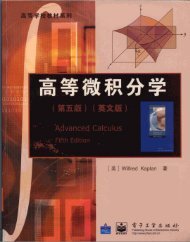Milne - Group Theory.. - Free
Milne - Group Theory.. - Free
Milne - Group Theory.. - Free
You also want an ePaper? Increase the reach of your titles
YUMPU automatically turns print PDFs into web optimized ePapers that Google loves.
2 1 BASIC DEFINITIONS<br />
A formal proof can be given using induction on n (Rotman 1995, 1.8). Thus, for any<br />
finite ordered set S of elements in G, ∏ a∈S<br />
a is defined (for the empty set S, weset<br />
it equal to 1).<br />
(d) The inverse of a 1 a 2 ···a n is a −1<br />
n a −1<br />
n−1 ···a −1<br />
1 , i.e., the inverse of a product is the<br />
product of the inverses in the reverse order.<br />
(e) Axiom (1.1c) implies that the cancellation laws hold in groups:<br />
ab = ac ⇒ b = c,<br />
ba = ca ⇒ b = c<br />
(multiply on left or right by a −1 ). Conversely, if G is finite, then the cancellation<br />
laws imply Axiom (c): the map x ↦→ ax: G → G is injective, and hence (by counting)<br />
bijective; in particular, 1 is in the image, and so a has a right inverse; similarly, it has<br />
a left inverse, and the argument in (b) above shows that the two inverses must then<br />
be equal.<br />
The order of a group is the number of elements in the group. A finite group whose<br />
order is a power of a prime p is called a p-group.<br />
For an element a of a group G, define<br />
⎧<br />
⎨ aa ···a n > 0 (n copies)<br />
a n = 1 n =0<br />
⎩<br />
a −1 a −1 ···a −1 n 0suchthata m =1;inthiscase,<br />
a n =1 ⇐⇒ m|n; moreovera −1 = a m−1 .<br />
Example 1.3. (a) For m ≥ 1, let C m = Z/mZ, andform = ∞, let C m = Z (regarded<br />
as groups under addition).<br />
(b) Probably the most important groups are matrix groups. For example, let R be<br />
a commutative ring. If A is an n × n matrix withcoefficients in R whose determinant<br />
is a unit 3 in R, then the cofactor formula for the inverse of a matrix (Dummit and<br />
Foote 1991, 11.4, Theorem 27) shows that A −1 also has coefficients 4 in R. In more<br />
detail, if A ′ is the transpose of the matrix of cofactors of A, thenA·A ′ =detA·I, and<br />
so (det A) −1 A ′ is the inverse of A. It follows that the set GL n (R) of suchmatrices is a<br />
2 We are using that Z is a principal ideal domain.<br />
3 An element of a ring is unit if it has an inverse.<br />
4 Alternatively, the Cayley-Hamilton theorem provides us with an equation<br />
A n + a n−1 A n−1 + ···±(det A) · I =0.

















